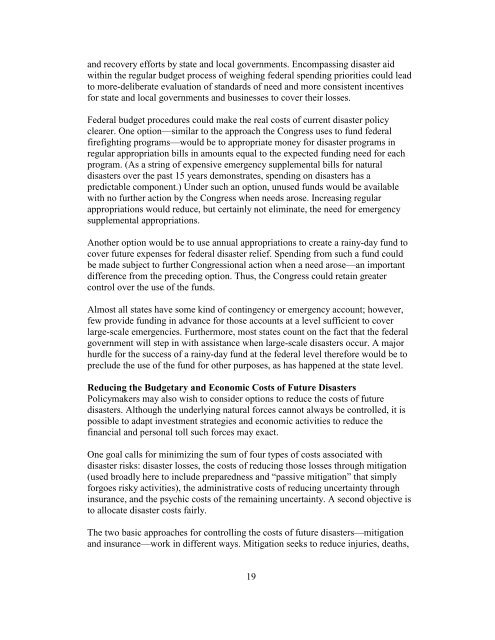Macroeconomic and Budgetary Effects of Hurricanes Katrina and Rita
Macroeconomic and Budgetary Effects of Hurricanes Katrina and Rita
Macroeconomic and Budgetary Effects of Hurricanes Katrina and Rita
Create successful ePaper yourself
Turn your PDF publications into a flip-book with our unique Google optimized e-Paper software.
<strong>and</strong> recovery efforts by state <strong>and</strong> local governments. Encompassing disaster aid<br />
within the regular budget process <strong>of</strong> weighing federal spending priorities could lead<br />
to more-deliberate evaluation <strong>of</strong> st<strong>and</strong>ards <strong>of</strong> need <strong>and</strong> more consistent incentives<br />
for state <strong>and</strong> local governments <strong>and</strong> businesses to cover their losses.<br />
Federal budget procedures could make the real costs <strong>of</strong> current disaster policy<br />
clearer. One option—similar to the approach the Congress uses to fund federal<br />
firefighting programs—would be to appropriate money for disaster programs in<br />
regular appropriation bills in amounts equal to the expected funding need for each<br />
program. (As a string <strong>of</strong> expensive emergency supplemental bills for natural<br />
disasters over the past 15 years demonstrates, spending on disasters has a<br />
predictable component.) Under such an option, unused funds would be available<br />
with no further action by the Congress when needs arose. Increasing regular<br />
appropriations would reduce, but certainly not eliminate, the need for emergency<br />
supplemental appropriations.<br />
Another option would be to use annual appropriations to create a rainy-day fund to<br />
cover future expenses for federal disaster relief. Spending from such a fund could<br />
be made subject to further Congressional action when a need arose—an important<br />
difference from the preceding option. Thus, the Congress could retain greater<br />
control over the use <strong>of</strong> the funds.<br />
Almost all states have some kind <strong>of</strong> contingency or emergency account; however,<br />
few provide funding in advance for those accounts at a level sufficient to cover<br />
large-scale emergencies. Furthermore, most states count on the fact that the federal<br />
government will step in with assistance when large-scale disasters occur. A major<br />
hurdle for the success <strong>of</strong> a rainy-day fund at the federal level therefore would be to<br />
preclude the use <strong>of</strong> the fund for other purposes, as has happened at the state level.<br />
Reducing the <strong>Budgetary</strong> <strong>and</strong> Economic Costs <strong>of</strong> Future Disasters<br />
Policymakers may also wish to consider options to reduce the costs <strong>of</strong> future<br />
disasters. Although the underlying natural forces cannot always be controlled, it is<br />
possible to adapt investment strategies <strong>and</strong> economic activities to reduce the<br />
financial <strong>and</strong> personal toll such forces may exact.<br />
One goal calls for minimizing the sum <strong>of</strong> four types <strong>of</strong> costs associated with<br />
disaster risks: disaster losses, the costs <strong>of</strong> reducing those losses through mitigation<br />
(used broadly here to include preparedness <strong>and</strong> “passive mitigation” that simply<br />
forgoes risky activities), the administrative costs <strong>of</strong> reducing uncertainty through<br />
insurance, <strong>and</strong> the psychic costs <strong>of</strong> the remaining uncertainty. A second objective is<br />
to allocate disaster costs fairly.<br />
The two basic approaches for controlling the costs <strong>of</strong> future disasters—mitigation<br />
<strong>and</strong> insurance—work in different ways. Mitigation seeks to reduce injuries, deaths,<br />
19
















